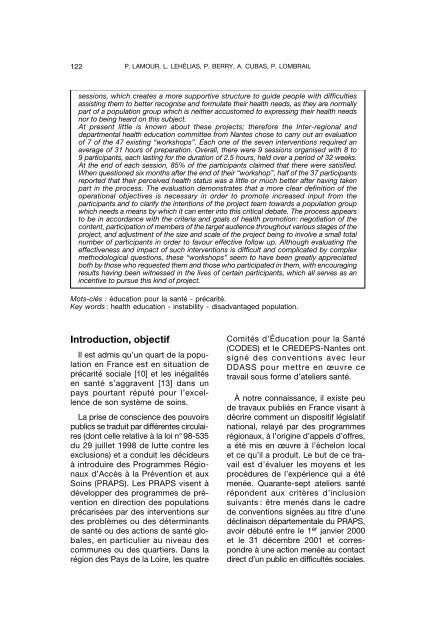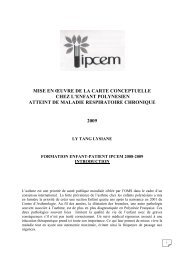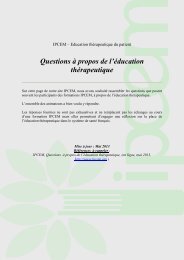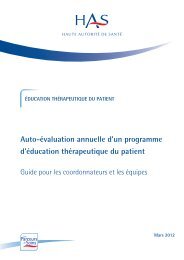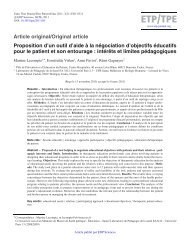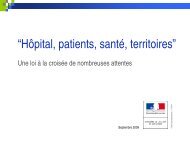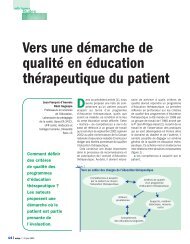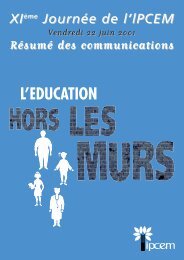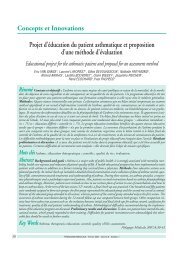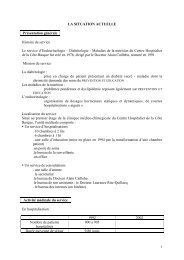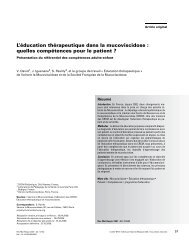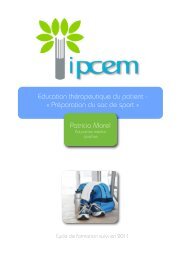Qu'est-ce qu'un atelier santé » ? L'expérience des Comités d ... - Ipcem
Qu'est-ce qu'un atelier santé » ? L'expérience des Comités d ... - Ipcem
Qu'est-ce qu'un atelier santé » ? L'expérience des Comités d ... - Ipcem
You also want an ePaper? Increase the reach of your titles
YUMPU automatically turns print PDFs into web optimized ePapers that Google loves.
122P. LAMOUR, L. LEHÉLIAS, P. BERRY, A. CUBAS, P. LOMBRAILsessions, which creates a more supportive structure to guide people with difficultiesassisting them to better recognise and formulate their health needs, as they are normallypart of a population group which is neither accustomed to expressing their health needsnor to being heard on this subject.At present little is known about these projects; therefore the Inter-regional anddepartmental health education committee from Nantes chose to carry out an evaluationof 7 of the 47 existing “workshops”. Each one of the seven interventions required anaverage of 31 hours of preparation. Overall, there were 9 sessions organised with 8 to9 participants, each lasting for the duration of 2.5 hours, held over a period of 32 weeks.At the end of each session, 85% of the participants claimed that there were satisfied.When questioned six months after the end of their “workshop”, half of the 37 participantsreported that their per<strong>ce</strong>ived health status was a little or much better after having takenpart in the pro<strong>ce</strong>ss. The evaluation demonstrates that a more clear definition of theoperational objectives is ne<strong>ce</strong>ssary in order to promote increased input from theparticipants and to clarify the intentions of the project team towards a population groupwhich needs a means by which it can enter into this critical debate. The pro<strong>ce</strong>ss appearsto be in accordan<strong>ce</strong> with the criteria and goals of health promotion: negotiation of thecontent, participation of members of the target audien<strong>ce</strong> throughout various stages of theproject, and adjustment of the size and scale of the project being to involve a small totalnumber of participants in order to favour effective follow up. Although evaluating theeffectiveness and impact of such interventions is difficult and complicated by complexmethodological questions, these “workshops” seem to have been greatly appreciatedboth by those who requested them and those who participated in them, with encouragingresults having been witnessed in the lives of <strong>ce</strong>rtain participants, which all serves as anin<strong>ce</strong>ntive to pursue this kind of project.Mots-clés : éducation pour la <strong>santé</strong> - précarité.Key words : health education - instability - disadvantaged population.Introduction, objectifIl est admis qu’un quart de la populationen Fran<strong>ce</strong> est en situation deprécarité sociale [10] et les inégalitésen <strong>santé</strong> s’aggravent [13] dans unpays pourtant réputé pour l’ex<strong>ce</strong>llen<strong>ce</strong>de son système de soins.La prise de conscien<strong>ce</strong> <strong>des</strong> pouvoirspublics se traduit par différentes circulaires(dont <strong>ce</strong>lle relative à la loi n° 98-535du 29 juillet 1998 de lutte contre lesexclusions) et a conduit les décideursà introduire <strong>des</strong> Programmes Régionauxd’Accès à la Prévention et auxSoins (PRAPS). Les PRAPS visent àdévelopper <strong>des</strong> programmes de préventionen direction <strong>des</strong> populationsprécarisées par <strong>des</strong> interventions sur<strong>des</strong> problèmes ou <strong>des</strong> déterminantsde <strong>santé</strong> ou <strong>des</strong> actions de <strong>santé</strong> globales,en particulier au niveau <strong>des</strong>communes ou <strong>des</strong> quartiers. Dans larégion <strong>des</strong> Pays de la Loire, les quatre<strong>Comités</strong> d’Éducation pour la Santé(CODES) et le CREDEPS-Nantes ontsigné <strong>des</strong> conventions avec leurDDASS pour mettre en œuvre <strong>ce</strong>travail sous forme d’<strong>atelier</strong>s <strong>santé</strong>.À notre connaissan<strong>ce</strong>, il existe peude travaux publiés en Fran<strong>ce</strong> visant àdécrire comment un dispositif législatifnational, relayé par <strong>des</strong> programmesrégionaux, à l’origine d’appels d’offres,a été mis en œuvre à l’échelon localet <strong>ce</strong> qu’il a produit. Le but de <strong>ce</strong> travailest d’évaluer les moyens et lesprocédures de l’expérien<strong>ce</strong> qui a étémenée. Quarante-sept <strong>atelier</strong>s <strong>santé</strong>répondent aux critères d’inclusionsuivants : être menés dans le cadrede conventions signées au titre d’unedéclinaison départementale du PRAPS,avoir débuté entre le 1 er janvier 2000et le 31 dé<strong>ce</strong>mbre 2001 et correspondreà une action menée au contactdirect d’un public en difficultés sociales.


